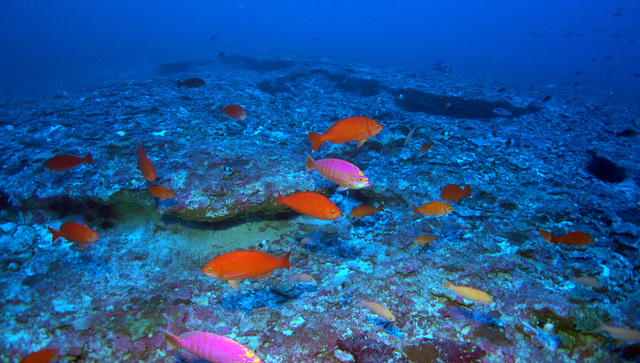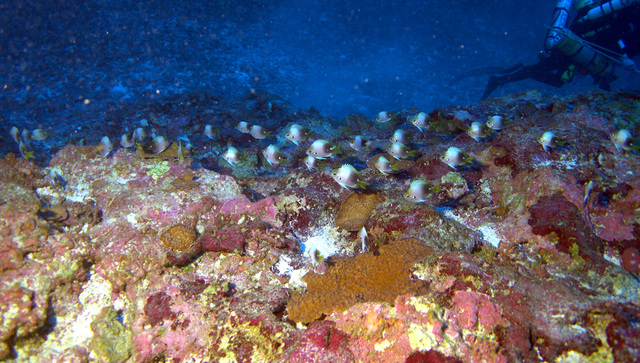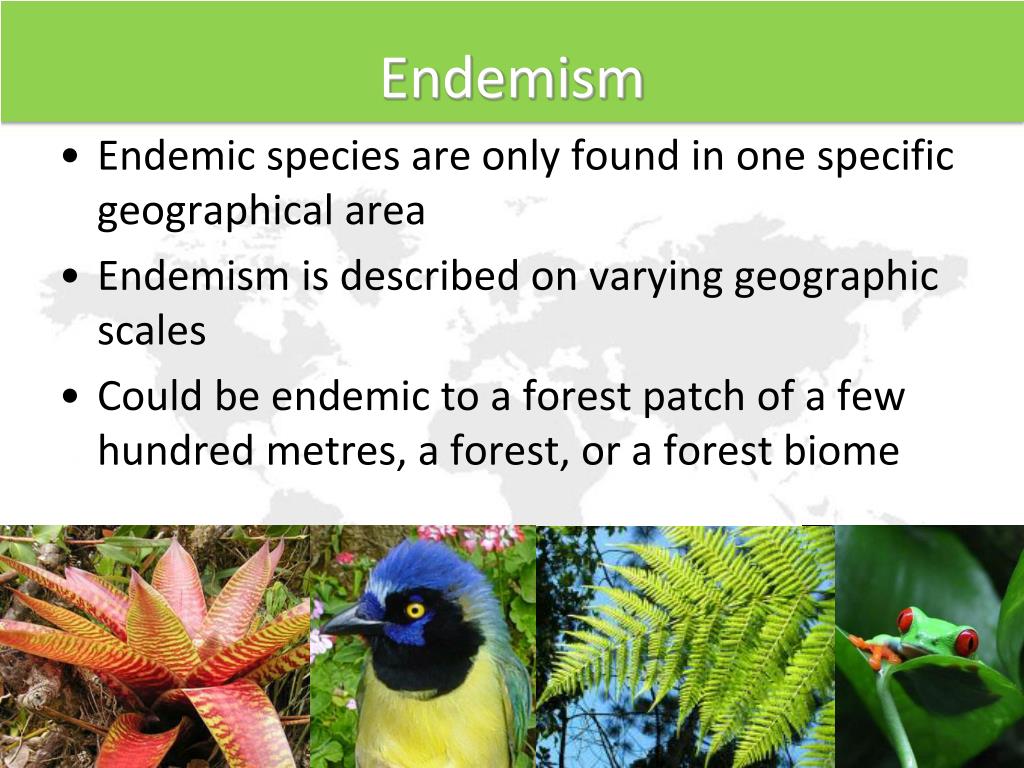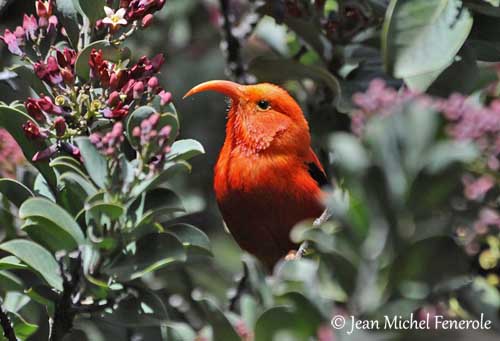Located about 2,300 miles (3,680 km) from the nearest continental shore, the Hawaiian Islands are the most isolated group of islands on the planet. The plant and animal life of the Hawaiian archipelago is the result of early, very infrequent colonizations of arriving species and the slow evolution of those species—in isolation from the rest of the world's flora and fauna—over a period of at least 5 million years. As a consequence, Hawai'i is home to a large number of endemic species. The radiation of species described by Charles Darwin in the Galapagos Islands which was critical to the formulation of his theory of evolution is far exceeded in the more isolated Hawaiian Islands.
The relatively short time that the existing main islands of the archipelago have been above the surface of the ocean (less than 10 million years) is only a fraction of time span over which biological colonization and evolution have occurred in the archipelago. High, volcanic islands have existed in the Pacific far longer, extending in a chain to the northwest; these once mountainous islands are now reduced to submerged banks and coral atolls. Midway Atoll, for example, formed as a volcanic island some 28 million years ago. Kure Atoll, a little further to the northwest, is near the Darwin point—defined as waters of a temperature that allows coral reef development to just keep up with isostatic sinking. And extending back in time before Kure, an even older chain of islands spreads northward nearly to the Aleutian Islands; these former islands, all north of the Darwin point, are now completely submerged as the Emperor Seamounts.
The islands are well known for the environmental diversity that occurs on high mountains within a trade winds field. On a single island, the climate can differ around the coast from dry tropical (< 20 in or 500 mm annual rainfall) to wet tropical; and up the slopes from tropical rainforest (> 200 in or 5,000 mm per year) through a temperate climate into alpine conditions of cold and dry climate. The rainy climate impacts soil development, which largely determines ground permeability, which affects the distribution of streams, wetlands, and wet places.
The distance and remoteness of the Hawaiian archipelago is a biological filter. Seeds or spores attached to a lost migrating bird's feather or an insect falling out of the high winds found a place to survive in the islands and whatever else was needed to reproduce. The narrowing of the gene pool meant that at the very beginning, the population of a colonizing species was a bit different from that of the remote contributing population. This list does not include species extinct in prehistoric times.
Island formation
Throughout time, the Hawaiian Islands formed linearly from northwest to the southeast. A study was conducted to determine the approximate ages of the Hawaiian Islands using K–Ar dating of the oldest found igneous rocks from each island. Kauai was determined to be about 5.1 million years old, Oahu about 3.7 million years old and the youngest island of Hawaii about 0.43 million years old. By determining the maximum age of the islands, inferences could be made about the maximum possible age of organisms inhabiting the island. The newly formed islands were able to accommodate growing populations, while the new environments were causing high rates of new adaptations.
Human arrival
Human contact, first by Polynesians and later by Europeans, has had a significant impact. Both the Polynesians and Europeans cleared native forests and introduced non-indigenous species for agriculture (or by accident), driving many endemic species to extinction. Fossil finds in caves, lava tubes, and sand dunes have revealed an avifauna that once had a native eagle, two raven-size crows, several bird-eating owls, and giant ducks known as moa-nalos. Around 861 species of plants have been introduced to the islands by humans since its discovery by Polynesian settlers, including crops such as taro and breadfruit.
Today, many of the remaining endemic species of plants and animals in the Hawaiian Islands are considered endangered, and some critically so. Plant species are particularly at risk: out of a total of 2,690 plant species, 946 are non-indigenous with 800 of the native species listed as endangered.
Terrestrial vertebrates
Mammals
- Hawaiian hoary bat (a.k.a. ʻŌpeʻapeʻa) (Lasiurus semotus) - endangered
- Hawaiian monk seal (a.k.a. ʻIlio-holo-i-ka-uaua) (Neomonachus schauinslandi) - endangered
- Synemporion keana (a species of vesper bat) - extinct
Birds
- Hawaiian duck (a.k.a. Koloa) (Anas wyvilliana) - endangered
- Laysan duck (Anas laysanensis) - critically endangered
- Nene (a.k.a. Hawaiian goose) (Branta sandvicensis) - near threatened
- Hawaiian petrel (Pterodroma sandwichensis) - endangered
- Newell's shearwater (a.k.a. Hawaiian shearwater or 'a'o) (Puffinus newelli) - critically endangered
- Hawaiian hawk (a.k.a. 'Io) (Buteo solitarius) - near threatened
- Laysan rail (Porzana palmeri) - extinct
- Hawaiian rail (Porzana sandwichensis) - extinct
- Hawaiian gallinule (Gallinula chloropus sanvicensis)
- Hawaiian coot (Fulica alai) - vulnerable
- Hawaiian stilt (Himantopus himantopus knudseni)
- Hawaiian black noddy (Anous minutus melanogenys)
- Pueo (Asio flammeus sandwichensis) - endangered
- Kauaʻi oʻo (Moho braccatus) - extinct
- Oʻahu ʻōʻō (Moho apicalis) - extinct
- Molokaʻi ʻōʻō (Moho bishopi) - extinct
- Hawaiʻi ʻōʻō (Moho nobilis) - extinct
- Kioea (Chaetoptila angustipluma) - extinct
- Kāmaʻo (Myadestes myadestinus) - extinct
- Puaiohi (Myadestes palmeri) - critically endangered
- Olomaʻo (Myadestes lanaiensis) - critically endangered/extinct
- ʻAmaui (Myadestes lanaiensis woahensis) - extinct
- ʻŌmaʻo (Myadestes obscurus) - vulnerable
- Millerbird (Acrocephalus familiaris) - critically endangered
- Hawaiʻi ʻelepaio (Chasiempis sandwichensis) - vulnerable
- Oʻahu ʻelepaio (Chasiempis ibidis) - endangered
- Kaua'i ʻelepaio (Chasiempis sclateri) - vulnerable
- Hawaiian crow (Corvus hawaiiensis) - extinct in the wild
- Laysan finch (Telespiza cantans) - vulnerable
- Nihoa finch (Telespiza ultima) - critically endangered
- Lesser koa finch (Rhodacanthus flaviceps) - extinct
- Greater koa finch (Rhodacanthus palmeri) - extinct
- Maui parrotbill (Pseudonestor xanthophrys) - critically endangered
- ʻŌʻū (Psittirostra psittacea) - critically endangered/extinct
- Palila (Loxioides bailleui) - critically endangered
- Lanaʻi hookbill (Dysmorodrepanis munroi) - extinct
- Kona grosbeak (Chlroidops kona) - extinct
- Common ʻamakihi (Hemignathus virens) - least concern
- Oʻahu ʻamakihi (Hemignathus flavus) - vulnerable
- Kauaʻi ʻamakihi (Hemignathus kauaiensis) - vulnerable
- Greater ʻamakihi (Hemignathus sagittirostris) - extinct
- Maui nukupuʻu (Hemignathus affinis) - critically endangered/extinct
- Kauaʻi nukupuʻu (Hemignathus hanapepe) - critically endangered/extinct
- Oʻahu nukupuʻu (Hemignathus lucidus) - extinct
- ʻAkiapolaʻau (Hemignathus munroi) - endangered
- ʻAnianiau (Magumma parva) - vulnerable
- Hawaiʻi ʻakialoa (Akialoa obscura) - extinct
- Kauaʻi ʻakialoa (Akialoa stejnegeri) - extinct
- Maui Nui ʻakialoa (Akialoa lanaiensis)- extinct
- Oahu ʻakialoa (Akialoa ellisiana) - extinct
- ʻAkekeʻe (Loxops caeruleirostris) - critically endangered
- Hawaiʻi ʻakepa (Loxops coccineus) - endangered
- Maui ʻakepa (Loxops ochraceus) - extinct
- Oʻahu ʻakepa (Loxops wolstenholmei) - extinct
- ʻAkikiki (Oreomystis bairdi) - critically endangered
- Hawaiʻi creeper (Oreomystis mana) - endangered
- Molokai creeper (Paroreomyza flammea) - extinct
- Oʻahu ʻalauahio (Paroreomyza maculata) - critically endangered/extinct
- Maui ʻalauahio (Paroreomyza montana) - endangered
- Lanaʻi ʻalauahio (Paroreomyza montana montana) - extinct
- ʻAkohekohe (a.k.a. Crested honeycreeper) (Palmeria dolei) - critically endangered
- Poʻouli (Melamprosops phaeosoma) - critically endangered/extinct
- ʻUla-ʻai-hawane (Ciridops anna) - extinct
- ʻIʻiwi (a.k.a. Scarlet honeycreeper) (Drepanis coccinea) - vulnerable
- Hawaiʻi mamo (Drepanis pacifica) - extinct
- Black mamo (Drepanis funerea) - extinct
- Laysan honeycreeper (Himantione fraithii) - extinct
- ʻApapane (Himantione sanguinea) - least concern
Freshwater fishes
- None of Hawaii's native fish are entirely restricted to freshwater (all are either anadromous, or also found in brackish and marine water in their adult stage).
- ʻOʻopu nākea (Awaous stamineus)
- Āholehole (Kuhlia xenura)
- ʻOʻopu ʻalamoʻo (Lentipes concolor) - data deficient
- ʻOʻopu naniha (Stenogobius hawaiiensis)
- ‘O‘opu ‘akupa (Eleotris sandwicensis) - data deficient
- ʻOʻopu nōpili (Sicyopterus stimpsoni) - near threatened
Terrestrial invertebrates
Insects
- Hyposmocoma (a genus of moths, such as the snail-eating caterpillar)
- Agrotis (a genus of moths)
- Drosophila (a genus of flies)
- Campsicnemus mirabilis (an extinct species of fly)
- Campsicnemus brevipes (a species of fly)
- Paralopostega (a genus of moths)
- Mestolobes (a genus of moths)
- Hypena (a genus of moths)
- Orthomecyna (a genus of moths)
- Helicoverpa (a genus of moths)
- Scotorythra (a genus of moths)
- Genophantis (a genus of moths)
- Tritocleis (a genus of moths)
- Eurynogaster (a genus of flies)
- Kamehameha butterfly (a.k.a. Pulelehua) (Vanessa tameamea)
- Green Hawaiian blue (Udara blackburni)
- Longhead yellow-faced bee (a.k.a. the Hawaiian yellow-faced bee) (Hylaeus longiceps)
- Thaumatogryllus (a genus of crickets)
- Wēkiu bug (Nysius wekiuicola)
- Drosophila sharpi (a rare species of fly)
- Koʻolau spurwing long-legged fly (an extinct species of fly
- Lanai pomace fly (an extinct species of fly)
- Phyllococcus oahuensis (a species of mealybug)
- Megalagrion (a genus of damselfly)
- Clavicoccus (a genus of mealybug)
- Dryophthorus distinguendus (a species of weevil)
- Laysan weevil (an extinct species of weevil)
- Rhyncogonus bryani (an extinct species of weevil)
- Manduca blackburni (an endangered species of hawkmoth)
- Thyrocopa (a genus of moths)
- Caconemobius nori (a species of cricket)
- Caconemobius howarthi (a species of cricket)
- Caconemobius schauinslandi (a species of cricket)
- Caconemobius varius (a species of cricket)
Crustaceans
- Atyoida bisulcata (a freshwater shrimp)
- Halocaridina (a genus of marine and brackish water shrimp)
- Hawaiian river shrimp (Macrobrachium grandimanus)
Spiders
- Ariamnes makue (a species of spider)
- Happy face spider (Theridion grallator)
- Kauaʻi cave wolf spider (Adelocosa anops) - endangered
- Orsonwelles, a genus of 13 species, each endemic to a single island
- Nihoa (a genus of spiders)
- Lycosa hawaiiensis (a species of spider)
Gastropods
Gastropods are snails.
- Oahu tree snails (Achatinella) - threatened, several already extinct
- Auriculella (a genus of land snails) - threatened, several already extinct
- Amastra (a genus of land snails) - many species extinct
- Carelia (a genus of land snails) - entire genus extinct
- Erinna (a genus of freshwater snails) - one vulnerable species, the other possibly extinct
- Gulickia alexandri (a land snail) - critically endangered
- Newcombia (a genus of land snails) - threatened, one already extinct
- Neritina granosa (a freshwater snail) - vulnerable
- Perdicella (a genus of land snails) - threatened, several already extinct
- Partulina (a genus of land snails) - threatened, several already extinct
Marine animals
Marine fishes
Cnidarians
- Finger coral (Porites compressa)
- Thick finger coral (Porites duerdeni)
- Brigham's coral (Porites brighami)
- Molokaʻi cauliflower coral (Pocillopora molokensis)
- Irregular rice coral (Montipora dilatata)
- Blue rice coral (Montipora flabellata)
- Sandpaper or Ringed rice coral (Montipora patula)
- Verril's lump coral (Psammocora verrilli)
- Serpentine cup coral (Eguchipsammia serpentina)
- Grand black coral (Antipathes grandis)
- Bicolor gorgonian (Acabaria bicolor)
- Small knob leather coral (Sinularia molokaiensis)
Plants
The Hawaiian Islands are home to dozens of endemic species and subspecies of plants, including endemic genera × Argyrautia, Argyroxiphium, Brighamia, Clermontia, Cyanea, Delissea, Dissochondrus, Dubautia, Haplostachys, Helodeaster, Hesperomannia, Hibiscadelphus, Hillebrandia, Isodendrion, Kokia, × Lindsaeosoria, Lipochaeta, Neraudia, Nothocestrum, Nototrichium, Pteralyxia, Remya, Rockia, Schiedea, Stenogyne, Touchardia, Trematolobelia, and Wilkesia.
The following list of endemic vascular plants is from Plants of the World Online, current and complete as of March 2025. Plants are listed alphabetically by order and family.
Lycopods
Lycopodiaceae
Selaginellaceae
- Selaginella deflexa Brack.
- Selaginella menziesii (Hook. & Grev.) Spring
- Selaginella sandvicensis Baker
Ferns
Aspleniaceae
Cyatheae
- Cibotium chamissoi Kaulf. – Oahu
- Cibotium glaucum (Sm.) Hook. & Arn.
- Cibotium × heleniae D.D.Palmer
- hāpuʻu ʻiʻi or Hawaiian tree fern (Cibotium menziesii Hook.)
- Cibotium nealiae Degen. – Kauai
Dennstaedtiaceae
- Hypolepis hawaiiensis Brownsey
- Microlepia × adulterina W.H.Wagner (M. setosa × M. speluncae) – Oahu
- Microlepia setosa var. mauiensis (W.H.Wagner) Miles K.Thomas – Maui and Hawaii
- Pteridium decompositum (Gaudich.) Christenh.
Gleicheniaceae
- Dicranopteris linearis f. emarginata (T.Moore) W.H.Wagner
- Diplopterygium pinnatum (Kunze) Nakai
- Sticherus owhyhensis (Hook.) Ching
Hymenophyllaceae
Lindsaeaceae
- × Lindsaeosoria W.H.Wagner (Lindsaea × Odontosoria)
- × Lindsaeosoria flynnii W.H.Wagner – Kauai
Marattiaceae
- Marattia douglasii (C.Presl) Baker
Ophioglossaceae
- † Botrychium subbifoliatum Brack.
Polypodiaceae
Psilotaceae
- Psilotum × intermedium W.H.Wagner (P. complanatum × P. nudum)
Pteridaceae
Alismatales
Hydrocharitaceae
- Halophila hawaiiana Doty & B.C.Stone
Apiales
Apiaceae
- Peucedanum sandwicense Hillebr.
- Sanicula kauaiensis H.St.John
- Sanicula mariversa Nagata & S.M.Gon
- Sanicula purpurea H.St.John & Hosaka
- Sanicula sandwicensis A.Gray
- Spermolepis hawaiiensis H.Wolff
Araliaceae
Pittosporaceae
Arecales
Arecaceae
Asparagales
Asparagaceae
- Golden hala pepe (Dracaena aurea H.Mann) – Kauai
- Lanai hala pepe (Dracaena fernaldii (H.St.John) Jankalski) – Lanai
- Waianae Range hala pepe (Dracaena forbesii (O.Deg.) Jankalski) – Oahu
- Royal hala pepe (Dracaena halapepe (H.St.John) Jankalski) – Oahu
- Dracaena halemanuensis Jankalski
- Hawai'i hala pepe (Dracaena konaensis (H.St.John) Jankalski) – Hawaii
- Maui hala pepe (Dracaena rockii (H.St.John) Jankalski) – Molokai, Maui
Asteliaceae
- Astelia argyrocoma A.Heller ex Skottsb. – Kauai
- Puaʻakuhinia (Astelia menziesiana Sm.)
- Pa'iniu (Astelia waialealae Wawra) – Kauai
Iridiaceae
- Sisyrinchium acre H.Mann – eastern Maui and Hawaii
Orchidaceae
- Hawai'i jewel orchid (Anoectochilus sandvicensis Lindl.)
- Hawai'i widelip orchid (Liparis hawaiensis H.Mann)
- Hawai'i bog orchid (Peristylus holochila (Hillebr.) N.Hallé)
Asterales
Asteraceae
Campanulaceae
Goodeniaceae
- Scaevola × cerasifolia Skottsb. (S. gaudichaudiana × S. mollis)
- Scaevola chamissoniana Gaudich.
- Scaevola coriacea Nutt.
- Scaevola gaudichaudiana Cham.
- Scaevola gaudichaudii Hook. & Arn.
- Scaevola glabra Hook. & Arn.
- Scaevola hobdyi W.L.Wagner – western Maui
- Scaevola kilaueae O.Deg.
- Scaevola mollis Hook. & Arn.
- Scaevola procera Hillebr.
Boraginales
Boraginaceae
- Nama sandwicensis A.Gray
Brassicales
Brassicaceae
- Lepidium arbuscula Hillebr.
- Lepidium bidentatum var. owaihiense (Cham. & Schltdl.) Fosberg
- † Lepidium bidentatum var. remyi (Drake) Fosberg – Hawaii; last recorded in 1949.
- Lepidium orbiculare H.St.John
- Lepidium serra H.Mann
Capparaceae
- Capparis sandwichiana DC.
Caryophyllales
Amaranthaceae
Caryophyllaceae
Nyctaginaceae
- Boerhavia herbstii Fosberg
- Ceodes wagneriana (Fosberg) E.F.S.Rossetto & Caraballo – Kauai
- Rockia Heimerl
- Rockia sandwicensis (Hillebr.) Heimerl
Phytolaccaceae
- Phytolacca sandwicensis Endl.
Polygonaceae
- Rumex albescens Hillebr.
- Rumex giganteus W.T.Aiton
- Rumex skottsbergii O.Deg. & I.Deg.
Portulacaceae
- Portulaca molokiniensis Hobdy
- Portulaca sclerocarpa A.Gray
- Portulaca villosa Cham.
Cornales
Hydrangeaceae
- Kanawao (Hydrangea arguta (Gaudich.) Y.De Smet & Granados)
Cucurbitales
Begoniaceae
- Hillebrandia Oliv.
- Hillebrandia sandwicensis Oliv.
Cucurbitaceae
Ericales
Ebenaceae
- Diospyros hillebrandii (Seem.) Fosberg – Kauai and Oahu
- Diospyros sandwicensis (A.DC.) Fosberg
Ericaceae
- Vaccinium calycinum Sm.
- Vaccinium dentatum Sm.
- Vaccinium reticulatum Sm.
Pentaphylacaceae
- Eurya sandwicensis A.Gray
Primulaceae
Sapotaceae
- Planchonella sandwicensis (A.Gray) Pierre
- Planchonella spathulata (Hillebr.) Pierre
Fabales
Fabaceae
Gentianales
Apocynaceae
Gentianaceae
- Schenkia sebaeoides (A.Gray) Griseb.
Loganiaceae
Rubiaceae
Geraniales
Geraniaceae
- Geranium arboreum A.Gray – Maui
- Geranium cuneatum Hook. – western and central Hawaii
- Geranium hanaense A.C.Medeiros & H.St.John – eastern Maui
- Geranium hillebrandii Aedo & Muñoz Garm. – northwestern Maui
- Geranium kauaiense (Rock) H.St.John – Kauai
- Geranium multiflorum A.Gray – eastern Maui
Gunnerales
Gunneraceae
- Gunnera kauaiensis Rock – Kauai
- Gunnera petaloidea Gaudich.
Huerteales
Dipentodontaceae
- Perrottetia sandwicensis A.Gray
- Perrottetia wichmaniorum Lorence & W.L.Wagner – Kauai
Isoetales
Isoetaceae
- Isoetes hawaiiensis W.C.Taylor & W.H.Wagner – Maui and Hawaii
Lamiales
Gesneriaceae
Lamiaceae
Oleaceae
- Notelaea sandwicensis (A.Gray) Hong-Wa & Besnard
Plantaginaceae
- Plantago hawaiensis (A.Gray) Pilg.
- Plantago pachyphylla A.Gray
- Plantago princeps Cham. & Schltdl.
Scrophulariaceae
- Myoporum stellatum (G.L.Webster) O.Deg. & I.Deg.
Laurales
Lauraceae
- Cryptocarya mannii Hillebr. – Kauai and Oahu
- Lindsaea knudsenii Hillebr. – Kauai
Liliales
Smilacaceae
- Smilax melastomifolia Sm.
Malpighiales
Euphorbiaceae
Phyllanthaceae
- Antidesma × kapuae Rock (A. platyphyllum × A. pulvinatum) – Hawaii: South Kona
- Antidesma platyphyllum H.Mann
- Antidesma pulvinatum Hillebr.
- Flueggea neowawraea W.J.Hayden
- Phyllanthus distichus Hook. & Arn.
Salicaceae
- Xylosma crenata (H.St.John) H.St.John – Kauai
- Xylosma hawaiensis Seem.
Violaceae
Malvales
Malvaceae
Thymelaeaceae
Myrtales
Myrtaceae
Piperales
Piperaceae
Poales
Cyperaceae
Joinvilleaceae
- Joinvillea ascendens Gaudich. ex Brongn. & Gris
Juncaceae
- Luzula hawaiiensis Buchenau
Poaceae
Oxalidales
Elaeocarpaceae
- Elaeocarpus bifidus Hook. & Arn. – Kauai and Oahu
Ranunculales
Papaveraceae
- Argemone glauca (Nutt. ex Prain) Pope
Ranunculaceae
- Ranunculus hawaiensis A.Gray
- Ranunculus mauiensis A.Gray
Rosales
Rhamnaceae
- Alphitonia ponderosa Hillebr.
- Colubrina oppositifolia Brongn. ex H.Mann
- Gouania hillebrandii Oliv. ex Hillebr.
- Gouania meyenii Steud.
- Gouania vitifolia A.Gray
Rosaceae
- † Acaena exigua A.Gray – Kauai, western Maui; last recorded in 2007
- Fragaria chiloensis subsp. sandwicensis (Decne.) Staudt
- ʻĀkala (Rubus hawaiensis A.Gray)
- ʻĀkalakala (Rubus macraei A.Gray)
Urticaceae
Salviniales
Marsileaceae
- Marsilea villosa Kaulf. – Niihau, Oahu, and Molokai
Santalales
Santalaceae
Sapindales
Anacardiaceae
- Rhus sandwicensis A.Gray
Rutaceae
Sapindaceae
- Alectryon macrococcus Radlk.
- Sapindus oahuensis Hillebr. ex Radlk.
- Sapindus thurstonii Rock
Schizaeales
Schizaeaceae
- Schizaea robusta Baker
Solanales
Convolvulaceae
- Bonamia menziesii A.Gray
- Cuscuta sandwichiana Choisy
- Ipomoea tuboides O.Deg. & Ooststr.
- Jacquemontia sandwicensis A.Gray
Solanaceae
Fungi
- Pholiota peleae
- Rhodocollybia laulaha
- Mycena marasmielloides
Hygrophoraceae
Hygrocybe
- Glowing like the sun Hygrocybe lamalama
- Slippery like a fish Hygrocybe pakelo
- Pink rose in the mist or rain forest Hygrocybe noelokelani
- Hygrocybe hapuuae
See also
- Canoe plants
- Endemic birds of Hawaii
- Hawaiian lobelioids
- List of fishes of the Coral Sea
- List of fish of Hawaii
- List of extinct animals of the Hawaiian Islands
- List of Hawaii birds
- List of invasive plant species in Hawaii
- List of animal species introduced to the Hawaiian Islands
- Peripatric speciation on the Hawaiian archipelago
References
Further reading
- Sakai A. K.; Wagner W.L.; Mehrhoff L. A. (2002). "Patterns of Endangerment in the Hawaiian Flora". Systematic Biology. 51 (2). Society of Systematic Biologists: 276–302. doi:10.1080/10635150252899770. PMID 12028733.
External links
- Flora of the Hawaiian Islands from the Smithsonian Institution




